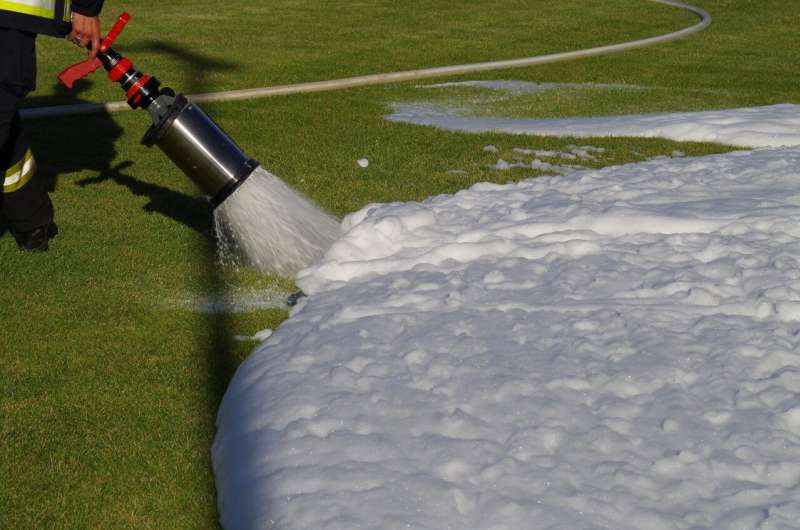
Firefighting foam can contain PFAS. Credit: Pixabay/CC0 Public Domain
An underground reservoir in Denmark is the location of a unique experiment: to test a technology for helping rid the environment of a widespread toxic pollution.
The aquifer, near the town of Korsør, contains high levels of per- and polyfluoroalkyl substances, or PFAS, which are chemicals that have been used worldwide since the 1940s in hundreds of goods, including firefighting foams. The chemicals contaminated the Korsør reservoir through runoff from a nearby firefighting school that used such foams in training exercises.
Huge headache
PFAS have concerned scientists since at least the 1990s. Known as “forever chemicals,” they don’t naturally break down, and can’t be removed from polluted soil and water by any existing method. They also increase the risk of cancer, immune-system disorders and other human health troubles.
“PFAS are a huge problem,” said Professor Francesco Dondero, an ecotoxicologist at the University of Eastern Piedmont in Italy. “Not only are they very persistent in the environment, but they are also extremely mobile.”
Dondero leads a research project that aims to improve PFAS detection and removal in Europe and beyond. Called SCENARIOS, the project runs for four years through October 2025 and has developed the technology being tested in Korsør.
Coveted by manufacturers for their ability to repel oil and water, PFAS are a common part of food packaging, waterproof clothing and stain-resistant fabrics. Production of the popular non-stick kitchenware coating Teflon releases PFAS into the environment.
The unique properties of PFAS are a result of their chemical structure, at the heart of which are chains of carbon atoms of various lengths surrounded by atoms of fluorine.
The carbon-fluorine bond is extremely strong and hard to break. As a result, PFAS persist in the environment for hundreds—maybe thousands—of years.
Chain reactions
“The types of PFAS with longer carbon chains can partially be removed from soil and water, but we currently have no tools for the short-chain ones,” said Dondero. “Sources of PFAS pollution are also very diffuse and we have no means of monitoring them.”
PFAS are released all over the world with wastewater from chemical plants—but not only.
They leak from landfills, contaminating the ground and surface water. Scientists have detected these harmful chemicals in Arctic ice-sheets, human breast milk and the drinking water of many major cities.
While some of the most dangerous types of PFAS have already been banned, many are still in use. As a result, their concentrations in the environment keep rising.
Personal perspective
Dondero’s interest in PFAS emerged after he moved to Alessandria, a town in northwestern Italy with a major chemical plant.
“I moved my family here 20 years ago and then discovered that local water resources have been contaminated with PFAS,” said Dondero. “They even found PFAS in the blood of local people. That’s why I put together this project.”
SCENARIOS brings together universities, research institutes, medical centers and companies from 11 countries: Cyprus, Denmark, Finland, Germany, Greece, Israel, Italy, Luxembourg, Spain, Sweden and the UK.
The tests in Korsør represent a culmination of the project’s work.
Promising results
The researchers have joined forces with a Swedish company, Envytech Solutions, to develop a way of removing short-chain PFAS without creating other pollution in the process.
The technique, called Surface Active Foam Fractionation, or SAFF, relies on tiny air bubbles. Researchers pump and treat contaminated water from the aquifer into a tank and blow in air at the bottom. As the bubbles rise through the tank, they collect the water-repelling PFAS molecules and bring them to the surface.
“These air bubbles have enormous affinity to PFAS and increase their concentrations at the surface by a factor of 100 000, ultimately allowing the final PFAS waste to be concentrated to levels exceeding a million times,” said Dondero.
The demonstration started in February 2024 and will last until September.
The researchers are testing various substances that could be added to the water to improve the effectiveness of the removal process, especially with regard to the hard-to-tackle short-chain PFAS.
So far, the results are promising. In some cases, the system was able to remove more than 99% of the contamination, according to Dondero.
The next step will be for the researchers to examine how to destroy the concentrated PFAS waste in a safe manner.
“For now, it would be enough if we can just store it somewhere until the destruction technology is developed,” Dondero said.
Search for substitutes
SCENARIOS is part of a cluster of health research projects that support the European Green Deal and advance an EU Zero Pollution Action Plan from 2021.
The plan foresees that, by 2050, concentrations of dangerous pollutants in air, soil and water decrease to levels no longer considered harmful to health and natural ecosystems.
As part of the strategy, PFAS should be phased out unless their use is deemed essential.
But creating a non-toxic, degradable and affordable replacement is no easy task.
“In nature, there is no other alternative that gives you the kinds of properties that PFAS have,” said Dr. Miika Nikinmaa, a biomaterials researcher at the VTT Technical Research Center of Finland. “They are also very cost competitive.”
Nikinmaa leads an EU-funded project to develop safe and sustainable alternatives to PFAS for use in food packaging and upholstery.
Called ZeroF, the three-year project is due to run until the end of 2025.
For packaging applications, the researchers are experimenting with fatty acid modified cellulose together with novel coating methods and chemistries to produce the desired properties of resistance to water and oil.
“We have been quite successful creating the water-barrier function,” Nikinmaa said. “The oil barrier is more difficult. But the most difficult thing is to achieve both at the same time.”
Legislative appeal
To replace PFAS in textiles and upholstery, the researchers are trying out a type of organic-inorganic polymer called ORMOCER. It was developed by the Germany-based Fraunhofer Institute for Silicate Research, which is a ZeroF partner.
The material can be combined with various coatings to match as closely as possible the properties of PFAS.
By the end of the project, the researchers hope to have developed and tested safe and sustainable PFAS alternatives that would be no more than 20% costlier.
Nonetheless, Nikinmaa says that overcoming PFAS contamination will require help from policymakers in Europe through new rules, including possible wider bans.
“I don’t expect a major technology leap to happen that would enable us to replace PFAS in all the applications, in a cost-competitive way, in the near future without major changes in legislation,” he said. “They are simply too cost-effective and too convenient. All the new technologies are more complex and therefore more expensive.”
Dondero of SCENARIOS drove home the point by saying stricter prohibitions on PFAS are needed.
“We need to start introducing restrictions to force the industry to phase them out,” he said. “We won’t be able to ban them in all industries at once, but we need to start somewhere.”
Citation:
Researchers test ways to remove ‘forever chemicals’ from the environment and replace them in commercial goods (2024, May 21)
retrieved 21 May 2024
from https://phys.org/news/2024-05-ways-chemicals-environment-commercial-goods.html
This document is subject to copyright. Apart from any fair dealing for the purpose of private study or research, no
part may be reproduced without the written permission. The content is provided for information purposes only.
>>> Read full article>>>
Copyright for syndicated content belongs to the linked Source : Phys.org – https://phys.org/news/2024-05-ways-chemicals-environment-commercial-goods.html































